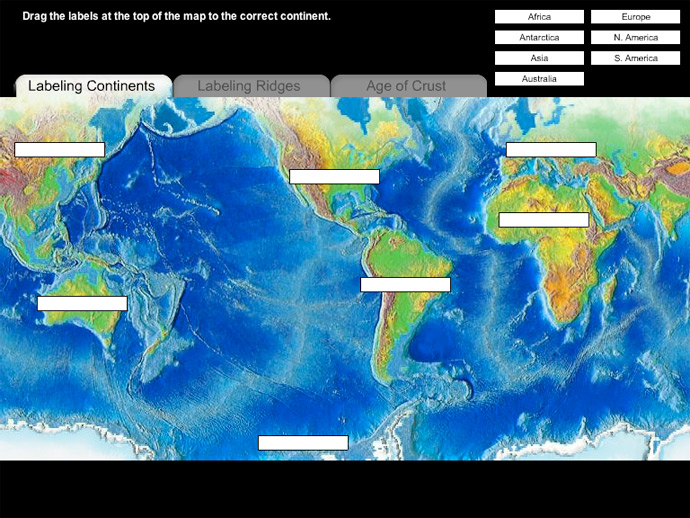Mid-Ocean Ridge Activity
This activity consists of naming the continents, identifying mid-ocean ridges, and determining the age of the ocean floor. Once you have labeled each map correctly, you should be able to answer the series of questions that follow the exercise.
The final map will allow you to explore all of the maps. Navigate by clicking through the images, which will provide different views of the maps, and show the relationship between the continents, mid-ocean ridges and the age of the ocean floor.
Questions
- Where is the youngest ocean floor located?
[Check Answer]
The youngest ocean floor is located on the mid-ocean ridge.
- Where is the oldest ocean floor located?
[Check Answer]
The oldest ocean floor is located near the continents, next to a subduction zone.
- There are rocks on every continent that are 3 to 4 billion years old. Why are there no oceanic rocks older than 200 million years?
[Check Answer]
Oceanic crust is eventually destroyed in subduction zones. Although oceanic crust has been forming on Earth for over 4 billion years, all of the sea floor older than about 200 million years has been recycled by plate tectonics. Continental crust is not subducted and destroyed, so very old continental rocks have survived.
- In the eastern Pacific, why are oceanic rocks no older than 120 million years?
[Check Answer]
The eastern Pacific Mid-Oceanic Ridge is not far from the subduction zone that runs along the west coast of South America. The ocean floor spreading eastward is subducted and destroyed relatively soon after formation.
- Based on the distribution of color on the map, which ridge is spreading faster, the Mid-Atlantic Ridge or the East Pacific Rise (ridge and rise are both nicknames for a mid-oceanic ridge)?
[Check Answer]
The East Pacific Rise is spreading faster than the Mid-Atlantic Ridge. The wide swath of red and orange parallel to the East Pacific Rise illustrates that a large area of oceanic rocks are very young.
- Based on the distribution of color on the map, which ridge is spreading faster, the Mid-Atlantic Ridge or the Southeast Indian Ridge?
[Check Answer]
The Southeast Indian Ridge is spreading faster than the Mid-Atlantic Ridge.
- How does the rate of spreading of the Southeast Indian Ridge compare to the Southwest Indian Ridge?
[Check Answer]
The Southeast Indian Ridge is spreading faster than the Southwest Indian Ridge.
Critical Thinking
If the mid-ocean ridges active today continue to produce new sea floor for another 100-200 million years, how will the appearance and location of oceans and continents be changed?Scientists seek to understand and explain how the natural world works. Many of the questions raised in this endeavor have no absolute answers.
The Pacific Ocean will probably disappear, swallowed up by subduction on its margins. The Atlantic will have widened enormously, pushing North and South America into Asia, Indonesia, and Australia. This new, giant land mass will likely be shoved far to the north by the spreading along the ridges that circle Antarctica, leaving that icy continent nearly alone in the southern hemisphere.
Related Links
Multimedia Discovery Missions: Lesson 2 - Mid-Ocean Ridges


